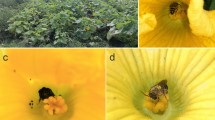Abstract
The prefeeding behaviours of adult crucifer flea beetles, Phyllotreta cruciferae (Coleoptera: Chrysomelidae: Alticinae), were determined on seedlings of the host plant, Brassica napus, and compared to behaviors on seedlings of the nonhost crucifers, Crambe abyssinica, Sinapis alba, and Camelina sativa. Three stages of prefeeding behaviour, i.e., acclimation, stimulation, and initial feeding, were distinguished through observation of filmed beetles. Both antennal and tarsal chemoreceptors are important in determination of host plant quality by the crucifer flea beetle. The results of this study suggest that the sequence of prefeeding behaviors plays a crucial role in the onset of feeding. Differences in time spent on plant tissue and the frequency and duration of prefeeding behaviors provide insight into possible mechanisms of resistance to flea beetles in the non-Brassica crucifers. The nonpreferred hosts C. abyssinica and S. alba contain deterrent phytochemicals that partially inhibit feeding. These deterrent compounds appear to be volatile in nature in S. alba but nonvolatile in C. abyssinica. CFB resistance in the nonhost C. sativa may result from either the presence of repellent or the absence of stimulatory volatile phytochemicals.
Similar content being viewed by others
REFERENCES
Adati, T., and Matsuda, K. (1993). Feeding stimulants for various leaf beetles (Coleoptera: Chrysomelidae) in the leaf surface wax of their host plants. Appl. Entomol. Zool. 28: 319-324.
Anderson, M. D., Peng, C., and Weiss, M. J. (1992). Crambe, Crambe abyssinica, Hochst., as a flea beetle resistant crop (Coleoptera: Chrysomelidae). J. Econ. Entomol. 85: 594-600.
Bernays, E. A., Blaney, W. M., Chapman, R. F., and Cook, A. G. (1976). The ability of Locusta migratoria to perceive plant surface waxes. Symp. Biol. Hung. 16: 35-40.
Bodnaryk, R. P., and Lamb, R. J. (1991). Mechanisms of resistance to the flea beetle, Phyllotreta cruciferae (Goeze), in mustard seedlings, Sinapis alba L. Can. J. Plant Sci. 71: 13-20.
Bowdan, E., and Wyse, G. A. (1997). Removing antennae and maxillae has little effect on feeding on normal host plants by two species of caterpillar. J. Insect Physiol. 43(11): 1053-1063.
Burgess, L. (1977). Flea beetles (Coleoptera: Chrysomelidae) attacking rape crops in the Canadian prairie provinces. Can. Entomol. 109: 21-32.
Chapman, R. F. (1982). The Insects: Structure and Function, Harvard University Press, Cambridge, MA, pp. 632-633.
Chun, M. W., and Schoonhoven, L. M. (1973). Tarsal contact chemosensory hairs of the large white butterfly, Pieris brassicae, and their possible role in oviposition behavior. Entomol. Exp. Appl. 16: 343-357.
Finch, S. (1978). Volatile plant chemicals and their effect on host plant finding by the cabbage root fly (Delia brassicae). Entomol. Exp. Appl. 24: 150-159.
Harrison, G. D. (1987). Host-plant discrimination and evolution of feeding preferences in the Colorado potato beetle, Leptinotarsa decemlineata. Physiol. Entomol. 12: 407-415.
Hicks, K. L. (1974). Mustard oil glycosides: Feeding stimulants for adult cabbage flea beetles, Phyllotreta cruciferae (Coleoptera: Chrysomelidae). Ann. Entomol. Soc. Am. 67: 261-264.
Hopkins, R. J., Birch, A. N. E., Griffiths, D. W., Baur, R., Stadler, E., and McKinlay, R. G. (1997). Leaf surface compounds and oviposition preference of turnip root fly, Delia floralis: The role of glucosinolate and nonglucosinolate compounds. J. Chem. Ecol. 23: 629-643.
Hopkins, R. J., Ekbom, B., and Henkow, L. (1998). Glucosinolate content and susceptibility for insect attack of three populations of Sinapis alba. J. Chem. Ecol. 24(7): 1203-1216.
Isidoro, N. Bartlet, E., Ziesmann, J., and Williams, I. H. (1998). Antennal contact chemosensilla in Psylliodes chrysocephala responding to cruciferous allelochemicals. Physiol. Entomol. 23: 131-138.
Kinoshita, G. B., Svec, H. J., Harris, C. R., and McEwen, F. L. (1979). Biology of the crucifer flea beetle, Phyllotreta cruciferae (Coleoptera: Chrysomelidae), in southwestern Ontario. Can. Entomol. 111: 1395-1407.
Kogan, M., and Ortman, E. E. (1978). Antixenosis—A new term proposed to replace Painter's “nonpreference” modality of resistance. Bull. Entomol. Soc. Am. 24: 175-176.
Lamb, R. J. (1984). Effects of flea beetles, Phyllotreta spp. (Chrysomelidae: Coleoptera), on the survival, growth, seed yield, and quality of canola, rape, and yellow mustard. Can. Entomol. 166: 269-280.
Lamb, R. J., and Turnock, W. J. (1982). Economics of insecticidal control of flea beetles (Coleoptera: Chrysomelidae) attacking rape in Canada. Can. Entomol. 114: 827-840.
Matsuda, K. (1988). Feeding stimulants of leaf beetles. in Jolivet, P., Petitpierre, E., and Hsiao, T. H. (eds.), Biology of Chrysomelidae, Kluwer Academic, Boston, pp. 40-55.
Mitchell, B. K. (1994). The chemosensory basis of host-plant recognition in Chrysomelidae. in Jolivet, P. H., Cox, M. L., and Petitpierre, E. (eds.), Novel Aspects of the Biology of Chrysomelidae, Kluwer Academic, Boston, pp. 141-151.
Mithen, R. (2001). Glucosinolates—Biochemistry, genetics and biological activity. Plant Growth Regul. 34: 91-103.
Nielsen, J. K. (1988). Crucifer-feeding Chrysomelidae: Mechanisms of host plant finding and acceptance. in Jolivet, P., Petitpierre, E., and Hsiao, T. H. (eds.), Biology of Chrysomelidae, Kluwer Academic, Boston, pp. 25-40.
Nielsen, J. K., Mads, L., Hansen, M. L., Agerbirk, N., Petersen, B. L., and Halkier, B. A. (2001). Responses of the flea beetles Phyllotreta nemorum and P. cruciferae to metabolically engineered Arabidopsis thaliana with an altered glucosinolate profile. Chemoecology 11:75-83.
Pachagounder, P., and Lamb, R. J. (1998). Feeding preferences of a flea beetle, Phyllotreta cruciferae (Coleoptera: Chrysomelidae), among wild crucifers. Can. Entomol. 130: 241-242.
Pachagounder, P., Lamb, R. J., and Bodnaryk, R. P. (1998). Resistance to the flea beetle Phyllotreta cruciferae (Coleoptera: Chrysomelidae) in false flax, Camelina sativa (Brassicaceae). Can. Entomol. 130: 235-240.
Palaniswamy, P., Lamb, R. J., and McVetty, P. B. E. (1992). Screening for antixenosis resistance to flea beetles, Phyllotreta cruciferae (Goeze) (Coleoptera: Chrysomelidae), in rapeseed and related crucifers. Can. Entomol. 124: 895-906.
Pelletier, Y., and Smilowitz, Z. (1990). Feeding behavior of the adult Colorado potato beetle, Leptinotarsa decemlineata (Say), on Solanum berthauthii Hawkes. Can. Entomol. 123: 219-230.
Peng, C., Weiss, M. J., and Anderson, M. D. (1992). Flea beetle (Coleoptera: Chrysomelidae) response, feeding and longevity on oilseed rape and crambe. Environ. Biol. 21(3): 604-609.
Rees, C. J. C. (1969). Chemoreceptor specificity associated with choice of feeding site by the beetle, Chrysolina brunsvicensis, on its food plant, Hypericum hirsutum. Entomol. Exp. Appl. 12: 565-583.
Ritcey, G. M., and McIver, S. B. (1990). External morphology of antennal sensillae of four species of adult flea beetles (Coleoptera: Chrysomelidae: Alticinae). J. Insect Morphol. Embryol. 19: 141-153.
Roessingh, P., Stadler, E., Baur, R., Hurter, J., and Ramp, T. (1997). Tarsal chemoreception and oviposition behaviour of the cabbage root fly (Delia radicum). Physiol. Entomol. 22: 140-148.
SAS Institute (2001). The SAS System for Windows, Release 8.02, SAS Institute Inc., Cary, NC.
SAS Institute (2002). JMP: The Statistical Discovery Software, Release 5.0, SAS Institute Inc., Cary, NC.
Schuster, A., and Friedt, T. (1998). Glucosinolate content and composition as parameters of quality of Camelina seed. Industr. Crops Products 7: 297-302.
Southwood, R. (1986). Plant surfaces and insects. in Juniper, B., and Southwood, R. (eds.), Insects and the Plant Surface, Edward Arnold, Baltimore, MD, pp. 1-22.
Sen, A. (1988). Ultrastructure of the sensory complex on the maxillary and labial palpi of the Colorado potato beetle, Leptinotarsa decemlineata. J. Morphol. 195: 159-175.
Stadler, E., Renwick, J. A. A., Radke, C. D., and Sachdev-Gupta, K. (1995). Tarsal chemoreceptor response to glucosinolates and cardenolides mediating oviposition in Pieris rapae. Physiol. Entomol. 20: 175-187.
Statistics Canada (2003). Field Crop Reporting Series No. 5. August 22, Ottawa, Canada.
Woodhead, S., and Padgham, D. E. (1987). The effect of plant surface characteristics on resistance of rice to the brown plant hopper, Nilaparvata lugens. Entomol. Exp. Appl. 47: 15-22.
Wylie, H. G. (1979). Observations on distribution, seasonal life history, and abundance of flea beetles (Coleoptera: Chrysomelidae) that infest rape crops in Manitoba. Can. Entomol. 111: 1345-1353.
Author information
Authors and Affiliations
Corresponding author
Rights and permissions
About this article
Cite this article
Henderson, A.E., Hallett, R.H. & Soroka, J.J. Prefeeding Behavior of the Crucifer Flea Beetle, Phyllotreta cruciferae, on Host and Nonhost Crucifers. Journal of Insect Behavior 17, 17–39 (2004). https://doi.org/10.1023/B:JOIR.0000025130.20327.1a
Issue Date:
DOI: https://doi.org/10.1023/B:JOIR.0000025130.20327.1a




